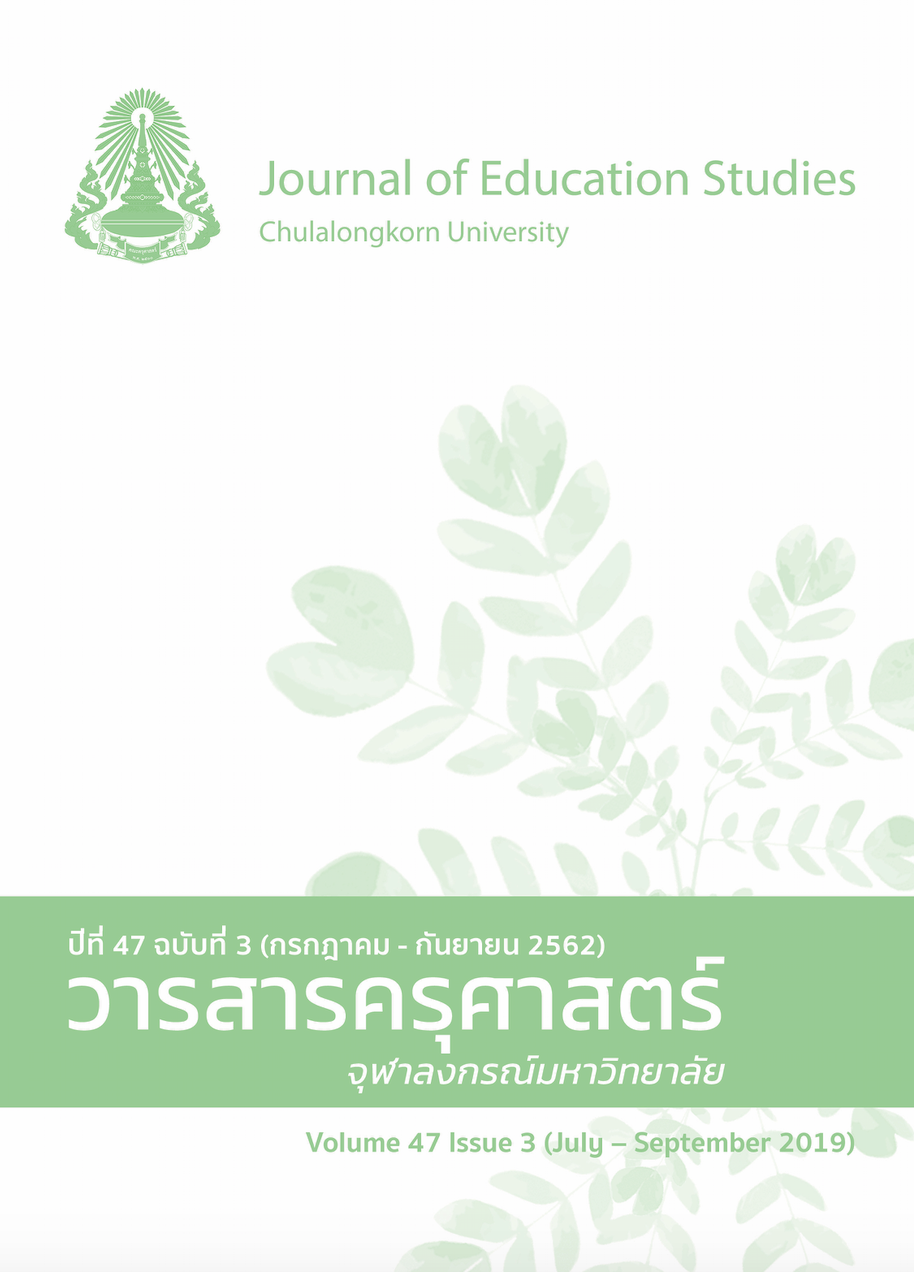Dinosaurs in the Classroom: A Review of Applications of Paleontology in Science Education
Keywords:
FOSSIL, PALAEONTOLOGY, PALAEONTOLOGY IN EDUCATION, SCIENCE EDUCATIONAbstract
Dinosaur and other fossils had a significant effect on human in terms of science, culture, economy and education for long time. The results of this study indicated that fossils were used in science and mathematics education in three functions: 1) to motivate and inspire students in classroom activity participation; 2) to explain some complex topics in science and math subject; 3) to understand scientist career and how does scientist work. The results show that fossils are used from childhood to secondary education. Moreover, paleontological research method is one of the most appropriate methods to develop teacher’s research skills. However, there are studies indicating the limitations of the use of fossils in science education, particularly, student’s age.
References
ภาษาไทย
เจษฎา นาจันทอง. (2553). การศึกษาศักยภาพเบื้องต้นของแหล่งซากดึกดำบรรพ์ภูเค็ง อำเภอท่าคันโท จังหวัดกาฬสินธุ์. ใน วราวุธ สุธีธร และ คณะ (บ.ก.), โครงการครุวิจัย–ซากดึกดำบรรพ์ (น. 86-90). กรุงเทพมหานคร: สำนักงานกองทุนสนับสนุนการวิจัย.
ณรงค์ฤทธิ์ ประเสริฐสุข. (2553). การศึกษาความสัมพันธ์ระหว่างขนาดรอยตีนกับความยาวลำตัวของสัตว์ปีก กรณีศึกษาไก่ ไก่งวง และนกยูง เพื่อประเมินขนาดลำตัวของไดโนเสาร์กลุ่มเทอโรพอด. ใน วราวุธ สุธีธร และ คณะ (บ.ก.), โครงการครุวิจัย–ซากดึกดำบรรพ์ (น. 110-114). กรุงเทพมหานคร: สำนักงานกองทุนสนับสนุนการวิจัย.
ปุณย์จรีย์ กัมปนาทโกศล. (2552). ผลของการจัดกิจกรรมวิทยาศาสตร์ตามแนวคิดคอนสตรัคติวิสต์ที่มีต่อทักษะกระบวนการทางวิทยาศาสตร์ของเด็กอายุ 6-7 ปี (วิทยานิพนธ์ปริญญามหาบัณฑิต ไม่ได้ตีพิมพ์). จุฬาลงกรณ์มหาวิทยาลัย, กรุงเทพมหานคร.
ราตรี สงวนรัมย์. (2553). การอนุรักษ์ซากดึกดำบรรพ์ของสัตว์มีกระดูกสันหลังในแหล่งขุดค้นภูน้อย อ.คำม่วง จ.กาฬสินธุ์. ใน วราวุธ สุธีธร และ คณะ (บ.ก.), โครงการครุวิจัย–ซากดึกดำบรรพ์ (น. 72-75). กรุงเทพมหานคร: สำนักงานกองทุนสนับสนุนการวิจัย.
วราวุธ สุธีธร, กมลลักษณ์ วงษ์โก, คมศร เลาห์ประเสริฐ, สุรเวช สุธีธร, และ ศักดิ์ชัย จวนงาม. (2553). โครงการครุวิจัย-ซากดึกดำบรรพ์. กรุงเทพมหานคร: สำนักงานกองทุนสนับสนุนการวิจัย.
สุริยา เฉลิมชาติ (2553). การศึกษาการลำดับชั้นหินในแหล่งซากดึกดำบรรพ์ภูปอ บ้านนาบอน ตำบลนาบอน อำเภอคำม่วง จังหวัดกาฬสินธุ์. ใน วราวุธ สุธีธร และ คณะ (บ.ก.), โครงการครุวิจัย–ซากดึกดำบรรพ์ (น. 34-37). กรุงเทพมหานคร: สำนักงานกองทุนสนับสนุนการวิจัย.
วุฒิศักดิ์ บุญแน่น. (2553). เรื่องเล่าจากครู: เรื่องเล่าจากครูวุฒิ ใน วราวุธ สุธีธร และ คณะ (บ.ก.), โครงการครุวิจัย–ซากดึกดำบรรพ์ (น. 233). กรุงเทพมหานคร: สำนักงานกองทุนสนับสนุนการวิจัย.
อรัญญา หมอกไชย. (2553). เรื่องเล่าจากครู: ประสบการณ์เกินร้อย...ภูกุ้มข้าว. ใน วราวุธ สุธีธร และ คณะ (บ.ก.), โครงการครุวิจัย–ซากดึกดำบรรพ์ (น. 241-242). กรุงเทพมหานคร: สำนักงานกองทุนสนับสนุนการวิจัย.
อรนุช เสียงดัง. (2553). เรื่องเล่าจากครู: กว่าจะถึงศูนย์วิจัยไดโนเสาร์...ภูกุ้มข้าว. ใน วราวุธ สุธีธร และ คณะ (บ.ก.), โครงการครุวิจัย–ซากดึกดำบรรพ์ (น. 240). กรุงเทพมหานคร: สำนักงานกองทุนสนับสนุนการวิจัย.
ภาษาอังกฤษ
Achiam, M., Simony, L., & Lindow, B. A. K. (2016). Objects prompt authentic scientific activities among learners in a museum programme. International Journal of Science Education, 38(6), 17-53.
Benton, M., & Harper, D. A. (2013). Introduction to paleobiology and the fossil record. West Sussex, UK: John Wiley & Sons.
Benton, M. J., Schouten, R., Drewitt, E. J. A., & Viegas, P. (2012). The bristol dinosaur project. Proceedings of the Geologists’ Association, 123(1), 210–225.
Brahier, J. D., & Bell, J. (2002). Dino-mite explorations. Teaching Children Mathematics, 8(9), 532-539.
Clary, R., & Wandersee, J. (2011). A coprolie mystery: Who dung it?. Science Scope, 34(7), 32-42.
Dudley, B. A. (1977). Sorting dinosaurs: An opportunity to teach mathematics with biology. International Journal of Mathematical Education in Science and Technology, 8(4), 417-443.
Fuentes, Q. S., Garruto, P., Lockard, F., Thompson, D., & Webb-Johnson, G. (2007). Mathematical explorations: What if we were built like the dinosaurs ?. Mathematics Teaching in the Middle School, 13(4), 249-256.
Guertin, L. A., Cao, T. E., Craig, A. K., George, E. A., Goldson, T. S., Makatche, S. P., … Williams, M. A. (2004). Bringing dinosaur science to the junior girl scouts through a college service-learning project. Journal of Science Education and Technology, 13(4), 523-531.
Hansen, T. A., & Slesnick, I. (2006). Adventures in paleontology: 36 classroom fossil activities. Arlington: National Science Teacher Association.
Harnmik, P., & Ross, R. (2003). Assessing data accuracy when involving students in authentic paleontological research. Journal of Geoscience Education, 51(1), 76-84.
National Science Foundation. (2017). Women, minorities, and persons with disabilities in science and engineering. Arlington: National Science Foundation.
Salmi, H., Thuneberg, H., & Vainikainen, M. P. (2016). Learning with dinosaurs: A study on motivation, cognitive reasoning, and making observations. International Journal of Science Education, Part B, 7(3), 1-16.
Strader, W. H., & Rinker, C. A. (1988). A child cented approach to dinosaur. Early child development and care, 43, 65-76.
Sedzielarz, M., & Robinson, C. (2007). Measuring growth on a museum field trip: Dinosaur bones and tree cross sections. Teaching Children Mathematics, 13(6), 292-298.
Teppo, A. R., & Hodgson, T. (2001). Dinosaur, dinosaur eggs and probability. The Mathematics Teacher, 94(2), 86-92.
Weinstein, P. S. (1981). Dinosaurs and arithmetic. The Arithmetic Teacher, 28(5), 38-40.
Yoon, S., Suh, J., & Park, S. (2014). Korean students' perception of scientific practices and understanding of nature of science. International Journal of Science Education, 36(16), 2666-2693.




